Who we are
100th anniversary of the Oppau explosion
The Oppau Explosion of 1921 – Remembering a Disaster
This film produced by BASF Corporate History and screened in collaboration with the City of Ludwigshafen am Rhein is dedicated to the victims of the explosion. It provides information on the incident, the likely causes and how the catastrophe was dealt with. It also describes the contribution Corporate History is making to keeping the memory of the event alive.
The disaster
On the morning of September 21, 1921, one of the worst disasters in modern industrial history occurred at the Oppau site. At 7:32 a.m., blasting work intended to loosen fertilizer ended in a catastrophic explosion in a fertilizer silo. The disaster resulted in over 500 fatalities and around 2,000 people were hurt, in some cases suffering severe injuries. The pressure wave was so strong that window panes burst in Heidelberg, Worms, Darmstadt and, in some cases, even in Frankfurt, located more than 80 kilometers away. The shock waves caused by the explosion were even registered in the seismological station in Munich, some 300 kilometers from Oppau.
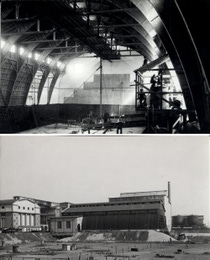
Interior and exterior of fertilizer silo Op 110 before the explosion, April 1921
Ammonium sulfate nitrate
There were roughly 4,500 metric tons of ammonium sulfate nitrate stored in the silo Op 110. This compound fertilizer tended to compact together and become as hard as rock during storage. It was therefore common practice to loosen the fertilizer using blasts with safety explosive and reduce it to grain size for transport. A series of explosion tests conducted in advance had seemingly proven this procedure to be safe. At the time the explosion occurred, more than 20,000 such loosening blasts had been conducted at BASF without any problems.
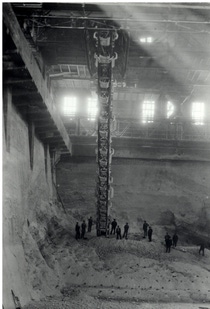
A look inside one of the fertilizer silos at the Oppau site, 1921
Initial aid and rescue measures
Aid was soon rushed to Oppau from near and far: volunteers, doctors and paramedics (including from large factories), fire departments and police departments, Red Cross branches and even from distant cities and municipalities. Classrooms were converted into makeshift hospitals and other rooms were used to house the homeless, while soup kitchens provided meals. The French occupation forces provided assistance, for example by sending in paramedics and law enforcement personnel. At the site itself, it was the workforce that carried out the initial rescue work.
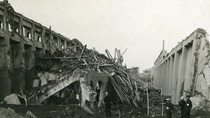
Rescue and emergency personnel in the ruins of a silo
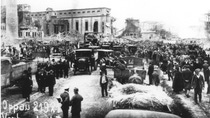
A temporary first aid station, photo: Stadtarchiv Ludwigshafen am Rhein
The damage
The extent of the damage was enormous. The Oppau site and the surrounding municipalities resembled a wasteland. A huge crater – 96 meters wide, 165 meters long and 18.5 meters deep – which filled with ground water marked the spot of the explosion.

The water-filled explosion crater
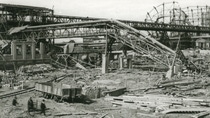
Destruction at the Oppau site
Outside the premises, the damage was greatest, as expected, in the municipality of Oppau that was closest to the site. Around 2,000 buildings were damaged, of which 1,036 were completely destroyed. Edigheim also suffered major property damage, though the extent was not as catastrophic as in Oppau. Cracks appeared in walls, roofs were blown away, glass panes burst and doors and windows were pressed out of their frames in Oggersheim, Frankenthal, Ludwigshafen, Mannheim and all the way to Worms and Heidelberg.
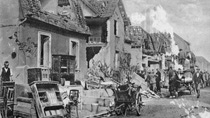.jpg)
Residents of Oppau with the ruins of their homes and livelihoods, photo: Stadtarchiv Ludwigshafen am Rhein
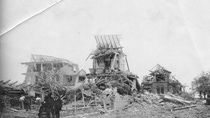
Destroyed housing in Oppau, photo: Stadtarchiv Ludwigshafen am Rhein
Grief and remembrance
On September 25, 1921, a memorial service was held at the main cemetery in Ludwigshafen for those who lost their lives and was attended by a large number of people. Numerous well-known personalities paid their respect to the victims, including the President of Germany, Friedrich Ebert, the Lord Mayors of Ludwigshafen and Mannheim, the heads of government from Bavaria and Baden and representatives of the French occupation administration. Memorials were also held in other municipalities in which victims lived. The memory of the victims is still kept alive at BASF to this day, for example with memorial services on anniversaries, by laying wreaths or through spoken or written commemorations.
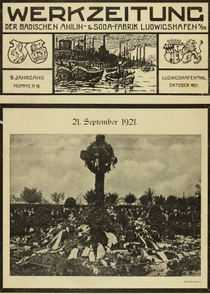
Honorary burial site at the main cemetery in Ludwigshafen (cover of the company newspaper published in October 1921)
The rebuilding
The reconstruction and providing for those who had suffered posed a major challenge to the site and municipality. Even shortly after the disaster, there was an overwhelming willingness to donate in support of the victims and bereaved, even far beyond the borders of the Palatinate. The rebuilding of Oppau was organized by the “Hilfswerk Oppau” relief agency founded by the Bavarian government. When the agency terminated its activities in 1924, more than 2,000 structures in Oppau and Edigheim had either been rebuilt or newly constructed. It only took 11 weeks for ammonia production to resume at the site. More than 10,000 construction workers from all parts of Germany participated in rebuilding the plant premises.

The company newspaper reports on the newly erected “big village” of Oppau in July 1925
Searching for the cause of the disaster
Immediately after the catastrophe, the Bavarian state parliament and the German parliament (Reichstag) decided to appoint inquiry committees. Numerous eyewitnesses and experts were called upon in an effort to clarify the circumstances of the disaster. However, the experts were unable to come up with a final assessment. In the light of systematic blasting tests and numerous trouble-free explosions, they were of the opinion that the plant management, plant chemists and supervisory authorities had acted in good faith and believed the explosions would not pose any danger. Thus, the Reichstag committee stated in its final report: “The explosion disaster in Oppau is one of those workplace accidents whose causes cannot be reliably determined despite all efforts during the investigation and despite calling upon experts from the fields of science and technology.” As a consequence of the disaster, production of ammonium sulfate nitrate was temporarily ceased at the site and later resumed with an improved process and taking all the new scientific findings into account.
What we know today
Today, the significant elements leading to the incident are known: The process modification in early 1921 (introduction of the spray-drying procedure) in the production of the fertilizer resulted in different physical properties of the ammonium sulfate nitrate; this in turn created the conditions that, contrary to previous assumptions, would allow the product to explode. Furthermore, a snow-like powder containing a significantly higher nitrate content formed in several places in the silo, which increased the explosive capability. It is likely that this “product snow” exploded during the blasts. In turn, this provided the spark: Another portion of the ammonium sulfate nitrate was now able to explode due to its modified physical properties, although the proper mixing ratio was used. Nonetheless, it is still not possible to conclusively clarify and verify the precise interaction between the individual factors.
